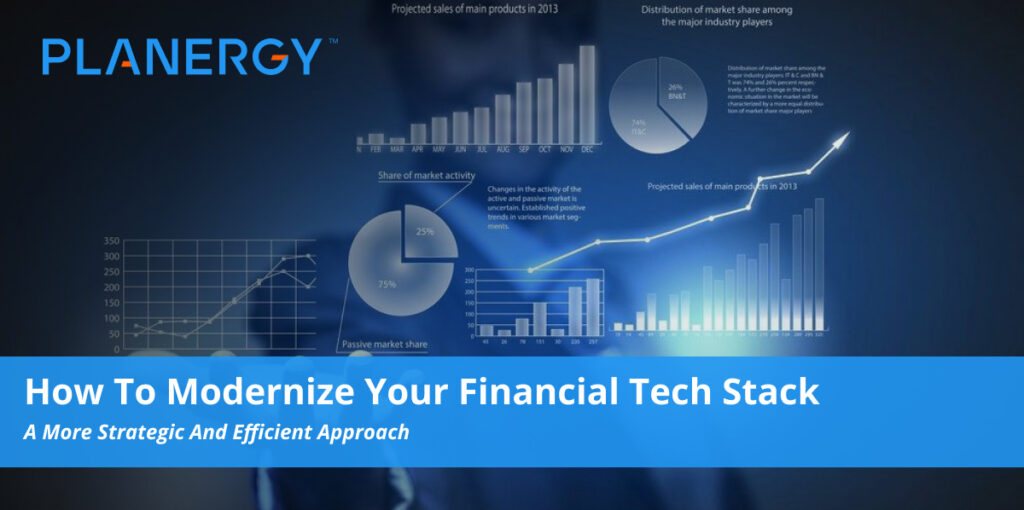Data in, data out; money in, money out. For today’s finance leaders, managing the flow of information is as critical as managing their organization’s cash flow effectively. Yet for many finance teams, collecting, organizing, and leveraging the flood of Big Data streaming through their organizations is easier said than done due to the limitations of their finance tech stack, or fintech.
Overcoming these limitations and finding the right digital tools to help transform financial data into useful reports, strategic spending, and actionable insights, is key. For savvy businesses, meeting today’s financial data management challenges means understanding their financial technology needs, identifying the areas most in need of update or replacement, and implementing the tools and strategies needed.
Why Your Finance Tech Stack Might Need an Upgrade
The modern finance function executes a range of duties. Finance teams often work closely with leaders from across their organizations—not only for expense management, but to collect, organize, and analyze data needed for effective budgeting, forecasting, and financial planning. Financial data dominates the workday, and the associated business processes are often complex, interdependent, and labyrinthine.
Data flows into finance from multiple internal and external sources, including:
- Billing systems
- Procurement software
- Customer data management systems
- Supplier data management systems
- Enterprise resource planning (ERP) solutions
- Human resources information system (HRIS)
- Industry data sources
- Banks and other financial institutions
Managing all this data to create actionable insights and produce useful reports for stakeholders—including managers in other business units, senior leadership in the C-suite, and external entities such as regulatory bodies and auditors—requires time, skill, and tenacity. It also requires adequate finance technology.
But what is “adequate” fintech in today’s business environment? Tackling such a massive amount of data with paper, pencil, and the odd Excel spreadsheet or two is time-consuming, tedious, and often produces results of minimum utility. For example, since business processes such as financial close take so long to complete, insights needed for the next financial period aren’t available until it’s well underway, hampering financial planning and strategic initiatives.
The financial tech stacks built by today’s industry leaders feature powerful new tools such as robotic process automation (RPA) and deep data analytics powered by machine learning. They are also focused on integration and collaboration in order to break down data silos, eliminate miscommunication, and promote a shared purpose supported by shared commitment from informed and proactive staff.
In order to handle the Big Data that drives modern financial services, both chief financial officers (CFOs) and the financial teams they lead need to:
- Identify their unique needs and the finance technology required to help meet them.
- Develop a strategy to implement the necessary tools and practices, including change management and alignment with organizational goals.
- Implement this strategy with a focus on maximum positive impact with minimal disruption of business activities.
Focusing on your biggest pain points first can help you establish a beachhead upon which you can build greater success.
Components of an Effective Financial Technology Stack
No two tech stacks will be precisely the same. The financial priorities of a new startup, for example, will likely be different to those of a mature corporation with multiple divisions. That said, some of the most common components built into modern fintech stacks include:
Accounting/Enterprise Resource Planning (ERP)
A company’s ERP package forms the trunk of its financial tree—and its tech stack. It is the central hub linking financial data drawn from other sources.
Financial Planning and Accounting (FP&A)
Monitoring (and, ideally, improving) financial performance, FP&A software uses key performance indicators (KPIs) to optimize business processes and provide actionable insights to enhance budgeting, financial planning, and strategic decision-making.
Payroll
Whether integrated with an HRIS or installed as a discrete application, payroll software is generally owned and used by the Human Resources department to manage data, compensation, and benefits for personnel. Finance relies heavily on payroll, however, as wages, salaries, benefits, and other staff expenses are a significant part of total spend for most organizations.
Spend Management
Used for both employee expense management and optimizing supplier spend, this software integrates finance with both HR and procurement.
Accounts Payable (AP)/Accounts Receivable (AR) Reconciliation
Getting paid and paying the bills requires complete visibility into, and control over, the complex workflows that drive AR and AP, respectively. Connecting AP to procurement also provides an opportunity to build value and cut costs by optimizing the procure-to-pay process (P2P process) from end to end.
Financial Close
Software solutions in this category support general bookkeeping for monthly close. Generally, these applications provide reconciliation, reporting, and workflow management tools so staff can close the books as quickly as possible without sacrificing accuracy.
Equity Management
Financial professionals use these applications to facilitate investor relations and manage their capitalization table.
Whether your financial tech stack includes some or all of these applications, it should be built to meet your specific needs, prioritize efficiency, integration, and collaboration, and contain the tools necessary to secure and maintain total buy-in from all stakeholders. After all, even the most powerful tools are useless if your team doesn’t want or know how to use them.
Optimizing Your Financial Tech Stack
Whether you’re a small startup or part of a large finance team at a megacorporation, you can ensure your finance tech stack is on solid ground by following some common best practices.
Start with Needs Analysis
Is your business still mired in the age of pen and paper? Struggling to integrate top-of-the-line but mutually-unintelligible software solutions? Suffering from a lack of standardization, vision, or transparency?
Whatever the case, the first step to fine-tuning your tech stack is needs analysis. Identify the business processes that are working, and those that need revamped or replaced. Highlight your biggest pain points and areas with unfavorable risk exposure. Prioritize corrective measures that will generate the most value and savings.
Remember, too, the importance of both collaboration and integration. Finance touches every part of your business, and everything from special projects to everyday tasks such as budgeting, pricing goods, and strategic sourcing rely on effective cross-functional collaboration.
Accordingly, whatever software solutions you choose should be mobile-friendly, intuitive, and able to integrate smoothly with both your data sources and the other applications in your software ecosystem.
Once you know what you need to improve, it’s much easier to select the tools and practices that will help you do so.
Develop a Strategy
You know what you need. Now it’s time to identify the tools that will get you there while meeting your requirements for budget, features, and accessibility—and then form a strategy to help you implement those tools with minimal disruption.
For example, a startup with a one-person finance team and minimal corporate infrastructure will likely build a stack focused on simplicity, ease of use, and scalability. They might rely on off-the-shelf software solutions with which they’re already familiar, such as Freshbooks or QuickBooks for bookkeeping, Gusto for payroll, and Microsoft Office for general document management. More forward-thinking startups may opt for a provider with a solution that lets them target their biggest pain points first and then expand functionality as their needs and budget grow.
Startups have an opportunity to build their stack from scratch, which can be a bit onerous at first but will smooth integration of future applications and minimize future disruptions, especially if they invest in a modular and purpose-built solution from the beginning.
A large corporation, on the other hand, will have the financial resources and infrastructure required to leap straight into a purpose-built, end-to-end solution that minimizes disruption of operations while enhancing collaboration and integration of current and legacy systems. They will likely need their solution to integrate with a range of existing applications such as Salesforce, Stripe, Oracle, etc. using EDI or API.
They might need to invest in educational materials to demonstrate value and secure buy-in (both conceptual and financial) from corporate leadership. They might also need to train up the staff in the rest of the organization to bring them in line with the new workflows and processes, especially if they’re transitioning from legacy systems.
While these two scenarios are quite different, both require a clear strategy in order to execute them effectively.
If you’re starting small, consider building your strategy around exploiting the largest opportunities for cost savings and value.
For example, both the P2P process and the financial close process are excellent places to begin optimizing your tech stack. These processes are chockablock with workflows that can be readily automated, reducing resource consumption, wasted time, and human error.
Implement Intelligently to Build on Your Success
Focusing on your biggest pain points first can help you establish a beachhead upon which you can build greater success. Automating workflows in your financial close, for example, will not only reduce the resources needed to produce timely (and therefore more useful) results, but free your team to focus their skills on more strategically valuable tasks.
In the P2P and spend management areas, automation paired with centralized data management also saves time by eliminating the need for time-consuming manual data entry. But it also enhances transparency, reduces risk, and allows for real-time monitoring of all spend. Gaining control over all your spend data makes it possible to analyze it much more accurately and effectively, especially with help from next-gen data analytics.
Machine learning drives both process automation and advanced analytics. Faster, more accurate business processes produce clean, actionable insights more quickly. Real-time reporting provides faster access to insights and improves everything from cash flow management to budgeting, strategic sourcing, and financial planning.
A modular, cloud-based, centralized software-as-a-service (SaaS) solution such as Planergy gives teams access to these tools from the jump, so they can start small and integrate their entire software ecosystem as time and resources allow, or go all-in with a bespoke software solution that centers finance and procurement as value drivers for their organizations.
In addition, choosing a centralized solution makes it much easier to prioritize integration, collaboration, and communication. By eliminating data silos and file format conflicts, providing mobile-friendly access from any platform, and connecting the disparate data sources finance needs to provide complete, accurate, and strategically useful financial information to stakeholders, these applications can help companies of all sizes scale the capabilities of their financial tech stack intuitively and easily.
A Solid Finance Tech Stack Supports Long-Term Success
Properly researched and implemented, fintech can give your organization the tools it needs to boost the speed, efficiency, and strategic utility of your financial processes and data. Make sure you’re stacking the deck in your favor by understanding your company’s needs, choosing tools that will adapt to meet those needs as they evolve, and implementing both tools and techniques in a strategic way.




